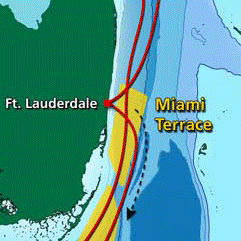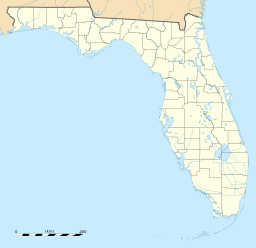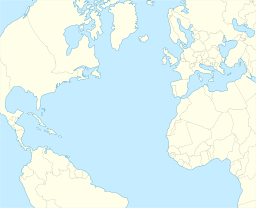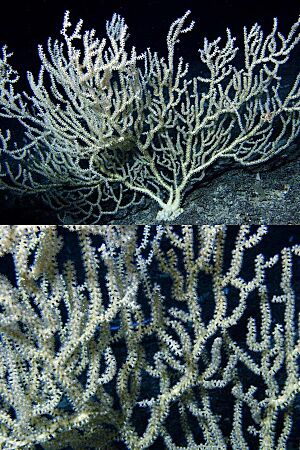Miami Terrace Reef facts for kids
Quick facts for kids Miami Terrace Reef |
|
|---|---|

Location of the Miami Terrace Reef. Image courtesy of NOAA Ocean Explorer (cropped).
|
|
| Location | |
| Location | North Atlantic |
| Coordinates | 25°45′N 79°55′W / 25.750°N 79.917°W |
| Country | United States |
| Geology | |
| Type | reef |
The Miami Terrace Reef (25°45′N 79°55′W / 25.750°N 79.917°W) is a special coral reef found off the coast of Florida. It stretches from South Miami all the way to Boca Raton in the Atlantic Ocean.
This reef sits on a natural underwater shelf called the Miami Terrace. This shelf is about 65 kilometers (40 miles) long. It is located about 24 kilometers (15 miles) from the shore. The reef is found at depths from about 200 to 600 meters (650 to 2,000 feet). Much of this underwater area is still a mystery. Scientists are still finding new parts of the reef! For example, researchers from the University of Miami found new reef spots in December 2005.
Contents
What Makes Up the Miami Terrace Reef?
The Miami Terrace is made of long, rocky ridges. These ridges are formed from limestone, which is a type of rock often found in oceans. These rocky areas are perfect homes, or habitats, for many different kinds of ocean life. You can find lots of corals, sponges, and fish living here.
Amazing Animals of the Reef
Many interesting fish live on the Miami Terrace Reef. Some of these include wreckfish, barrelfish, and bright red alfonsinos.
Scientists have also seen many cool invertebrates here. Invertebrates are animals without backbones. These include different types of corals like Lophelia pertusa coral and bamboo coral. You can also find various sponges and octocorals.
Other moving invertebrates have been seen too. These include crabs and sea urchins. Some specific ones are Asteroporpa sp. ophiuroids (a type of brittle star) and Stylocidaris sp. urchins. You might also spot different kinds of mollusks, sea anemones, and decapod crustaceans. Two examples of these crustaceans are Chaceon fenneri and Galatheidae.
Exploring the Miami Terrace Reef
Scientists have been studying the Miami Terrace for many years. The University of Miami (UM) started exploring this area in the 1970s. They studied the Miami Terrace's geology, which is how the Earth is made up. They also collected samples of the animals living on the reef.
In May 2004, a scientist named John Reed saw something amazing. During a submersible dive, he saw huge groups of 50 to 100 wreckfish! A submersible is a small underwater vehicle used for exploring. Later, in December 2005, a team from the University of Miami found even more new reef sites. They used a special robot called an autonomous underwater vehicle to make these discoveries.
Protecting the Reef
The corals on the Miami Terrace are very important. They can be harmed by certain types of fishing. For example, bottom trawling and dredging can damage these delicate coral areas.
- Bottom trawling is when a large fishing net is dragged along the seafloor.
- Dredging is when equipment is used to scoop up sediment from the bottom.
Because of these risks, there have been plans to protect the Miami Terrace. In 2004, the South Atlantic Fishery Management Council approved ideas to protect this area. They also wanted to protect other similar deep-sea coral areas. However, these plans were never fully put into action. Other nearby coral areas that also need protection include the Pourtales Terrace and Stetson Reef.




